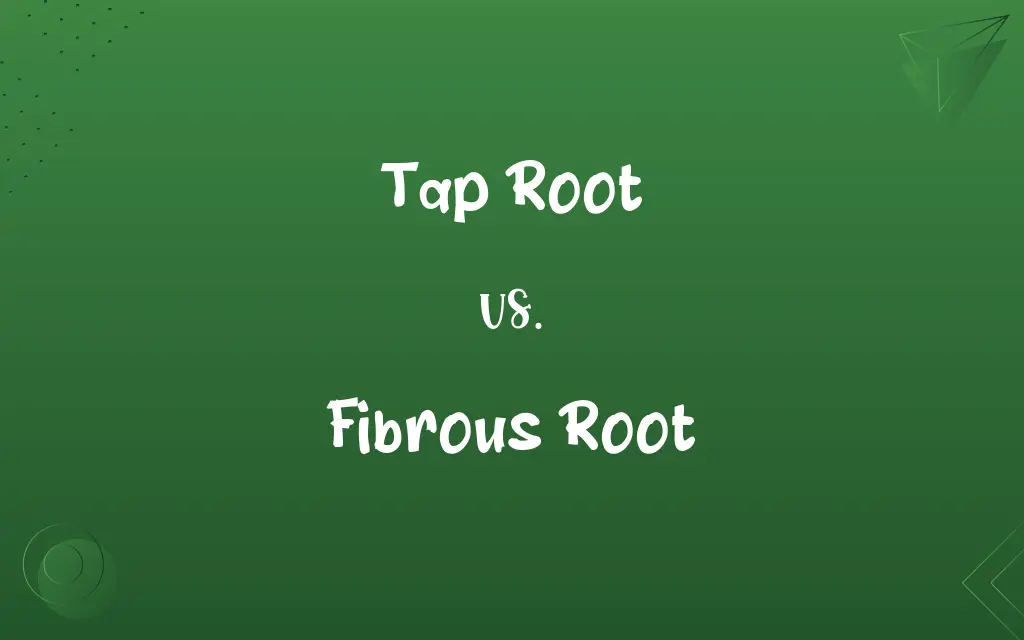Tap Root vs. Fibrous Root: Know the Difference

By Shumaila Saeed || Published on February 28, 2024
Tap root is a single, thick primary root growing vertically downward, while fibrous root is a network of many thin roots spreading out near the surface.

Key Differences
Tap roots are characterized by a single, thick primary root that grows directly downward, anchoring the plant deeply into the soil. In contrast, fibrous roots consist of numerous thin roots that branch out near the soil surface, providing a more dispersed and less deep rooting system.
Shumaila Saeed
Feb 28, 2024
The tap root system, seen in many dicotyledons, is adept at accessing deeper water sources, thanks to its primary root that penetrates deep into the soil. Fibrous roots, common in monocotyledons, excel in stabilizing the soil surface and efficiently absorbing nutrients from the topsoil.
Shumaila Saeed
Feb 28, 2024
In tap root systems, secondary roots emerge from the main root, but they are usually less numerous and thinner. Fibrous root systems lack a central dominant root, instead featuring a dense network of similarly sized roots that can quickly cover a wide area.
Shumaila Saeed
Feb 28, 2024
Plants with tap roots, like carrots, often store nutrients in their primary root, making them important for food production. Conversely, plants with fibrous roots, such as grasses, are excellent for preventing soil erosion due to their extensive surface root network.
Shumaila Saeed
Feb 28, 2024
Tap roots can penetrate compacted layers, reaching deep water sources, which is beneficial in arid environments. Fibrous roots, however, are more suited to absorbing moisture and nutrients from the soil surface, thriving in areas with abundant surface resources.
Shumaila Saeed
Feb 28, 2024
ADVERTISEMENT
Comparison Chart
Primary Function
Deep soil penetration and anchorage
Surface stabilization and nutrient absorption
Shumaila Saeed
Feb 28, 2024
Root Structure
Single, thick primary root with few branches
Numerous thin, branching roots
Shumaila Saeed
Feb 28, 2024
Typical Environment
Arid, where deep water access is essential
Topsoil-rich areas for surface nutrient uptake
Shumaila Saeed
Feb 28, 2024
Nutrient Storage
Often stores nutrients in the primary root
Less likely to store nutrients
Shumaila Saeed
Feb 28, 2024
Soil Erosion Control
Less effective due to deeper growth
Highly effective in preventing soil erosion
Shumaila Saeed
Feb 28, 2024
ADVERTISEMENT
Tap Root and Fibrous Root Definitions
Tap Root
A primary root growing directly downward from a plant stem.
The oak tree's tap root extends deep into the ground, providing stability.
Shumaila Saeed
Jan 13, 2024
Fibrous Root
Roots that lack a primary root but have many secondary roots.
The fibrous root system of onions aids in quick absorption of surface nutrients.
Shumaila Saeed
Jan 13, 2024
Tap Root
A central, dominant root from which other roots sprout laterally.
The carrot's tap root stores nutrients, making it edible and nutritious.
Shumaila Saeed
Jan 13, 2024
Fibrous Root
A shallow root system common in monocotyledons.
Corn plants, with their fibrous roots, stabilize the topsoil effectively
Shumaila Saeed
Jan 13, 2024
Tap Root
A root system characteristic of dicotyledons, featuring a main root.
The dandelion's tap root helps it survive in tough environmental conditions.
Shumaila Saeed
Jan 13, 2024
ADVERTISEMENT
Fibrous Root
A root system made up of many thin, branching roots near the surface.
Grasses have a fibrous root system that quickly covers the soil surface.
Shumaila Saeed
Jan 13, 2024
Tap Root
A root that penetrates deeply into the soil for water access.
In desert plants, the tap root reaches deep for scarce water sources.
Shumaila Saeed
Jan 13, 2024
Fibrous Root
A network of roots that spread out horizontally under the soil.
Wheat plants utilize their fibrous root system for efficient nutrient uptake.
Shumaila Saeed
Jan 13, 2024
Tap Root
A single, thick root that grows vertically downward from a seed.
The bean plant starts its growth with a prominent tap root.
Shumaila Saeed
Jan 13, 2024
Fibrous Root
Multiple roots of similar size forming a dense mat under the soil.
The fibrous roots of lawn grass help prevent soil erosion effectively.
Shumaila Saeed
Jan 13, 2024
Repeatedly Asked Queries
Can tap roots aid in drought resistance?
Yes, their depth allows them to access deep water sources.
Shumaila Saeed
Feb 28, 2024
What is a tap root?
A tap root is a single, large root that grows vertically downward, providing deep soil anchorage.
Shumaila Saeed
Feb 28, 2024
How deep can tap roots grow?
Tap roots can grow several meters deep, depending on the plant species.
Shumaila Saeed
Feb 28, 2024
Which plants have fibrous roots?
Most monocots, such as grasses, have fibrous roots.
Shumaila Saeed
Feb 28, 2024
What is a fibrous root?
A fibrous root system consists of many small roots spreading out near the soil surface.
Shumaila Saeed
Feb 28, 2024
Can fibrous roots grow deep?
Generally, they stay near the surface, but some can go deeper.
Shumaila Saeed
Feb 28, 2024
Do tap roots store nutrients?
Yes, some tap roots, like in carrots, store nutrients.
Shumaila Saeed
Feb 28, 2024
Do fibrous roots store nutrients?
Typically, they're less likely to store nutrients compared to tap roots.
Shumaila Saeed
Feb 28, 2024
What plants typically have tap roots?
Many dicots like carrots and trees have tap roots.
Shumaila Saeed
Feb 28, 2024
Can tap roots be eaten?
In some plants like beets and carrots, tap roots are edible.
Shumaila Saeed
Feb 28, 2024
Do all trees have tap roots?
Not all, but many tree species initially develop tap roots.
Shumaila Saeed
Feb 28, 2024
Do fibrous roots need a lot of space?
They spread wide but don't require deep soil.
Shumaila Saeed
Feb 28, 2024
Are tap roots visible above ground?
Usually not, as they grow deep underground.
Shumaila Saeed
Feb 28, 2024
Can tap roots regenerate if cut?
Some can regenerate, but it depends on the plant species.
Shumaila Saeed
Feb 28, 2024
Are fibrous roots good for soil erosion control?
Yes, they effectively stabilize the topsoil.
Shumaila Saeed
Feb 28, 2024
How do fibrous roots help in farming?
They improve soil structure and prevent nutrient runoff.
Shumaila Saeed
Feb 28, 2024
What's the main advantage of fibrous roots?
Their surface spread allows quick water and nutrient absorption.
Shumaila Saeed
Feb 28, 2024
How do tap roots affect gardening?
They can make transplanting and tilling more challenging.
Shumaila Saeed
Feb 28, 2024
Do tap roots help in anchoring large trees?
Yes, they provide stability to large trees, especially in windy conditions.
Shumaila Saeed
Feb 28, 2024
How do fibrous roots absorb nutrients?
They efficiently absorb nutrients and water from the topsoil.
Shumaila Saeed
Feb 28, 2024
Share this page
Link for your blog / website
HTML
Link to share via messenger
About Author
Written by
Shumaila SaeedShumaila Saeed, an expert content creator with 6 years of experience, specializes in distilling complex topics into easily digestible comparisons, shining a light on the nuances that both inform and educate readers with clarity and accuracy.









































































